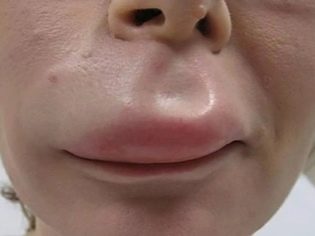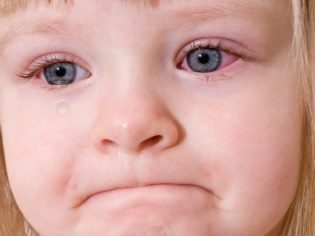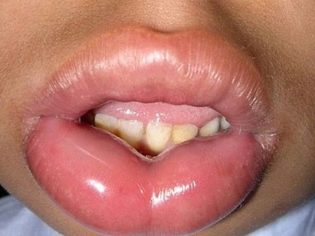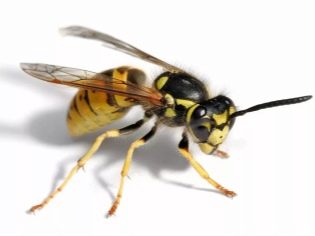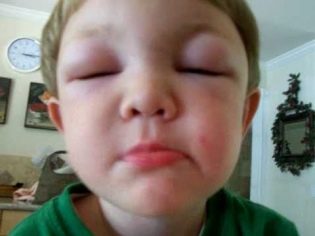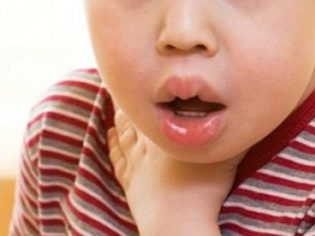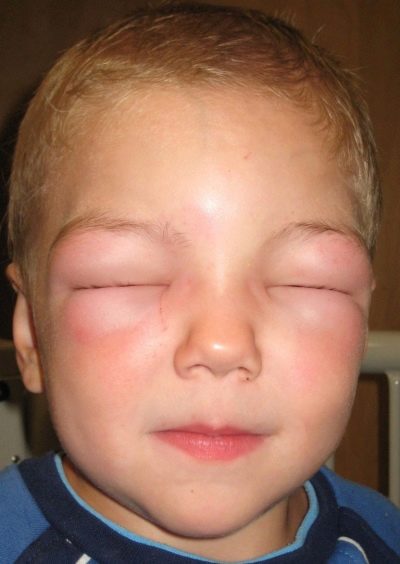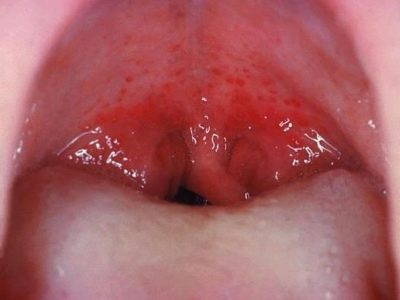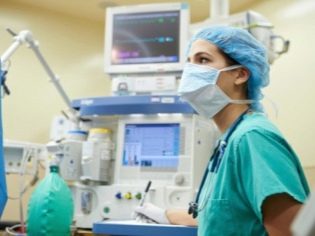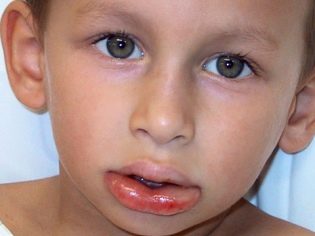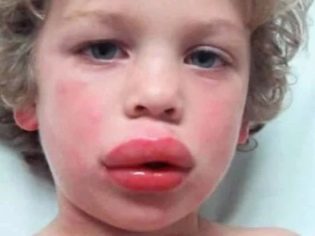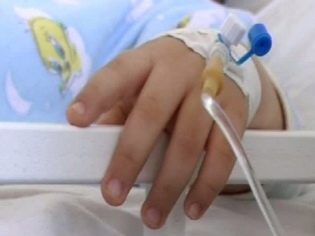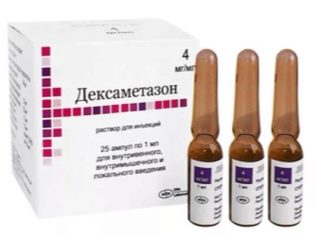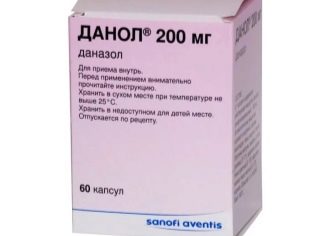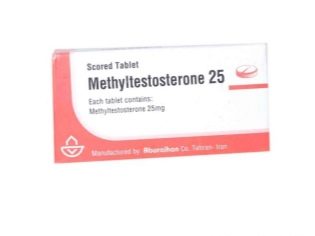Symptoms and treatment of angioedema in children
Acute allergies in children require immediate treatment. Any delay in providing assistance may lead to the most life-threatening consequences. One of these conditions is considered angioedema.
What it is?
Acute allergic reaction, in which there is a pronounced swelling of tissues on the face and upper half of the body, is called angioedema. Doctors may also refer to this pathological condition as angioedema. This pathology is associated with a rapid response of the immune system to the entry of a foreign allergen into the body. The development of Quincke edema mainly occurs in people having an individual hypersensitivity to some provoking allergens.
This pathological condition can develop at any age: both in newborns and adults. There are family cases of angioedema.
They are caused by the presence of a genetic defect in the structure of the gene encoding one of the components of the immune defense, the C1 inhibitor. There may be acquired forms of angioedema. In this case, the doctors are already talking about the presence of pseudo-hereditary angioedema.
According to statistics, in infants the disease is extremely rare. Only in 2-5% of cases in babies of infancy this pathological condition is recorded. However, angioedema occurs in very young children is usually quite hard. Features of the structure of the child's body and imperfect functioning of the immune system leads to the fact that the immune response can be much brighter than in adults. This usually contributes to the fact that an allergic reaction in a child after an allergen enters the body starts up quickly, and adverse symptoms occur within a few minutes.
The reasons
The development of angioedema can lead a variety of causal factors. It is almost impossible to predict in which case and for which child a dangerous clinical condition will arise. It is important to note that babies who are prone to allergic reactions or are allergic are always in a high risk zone.
The following causes may cause a child to have angioedema:
- The use of allergenic products. Usually, a strong acute allergic reaction occurs in a baby upon the first introduction of unfamiliar components. Contribute to the development of angioedema: cocoa beans confectionery, tropical fruits, citrus fruits, red berries (especially from other countries), seafood.
In some cases, the use of familiar and familiar foods when the child has an individual intolerance to them can lead to the appearance of adverse symptoms.
- Inhalation of pollen. In this case, seasonality is observed. Quincke swelling usually occurs in babies predisposed to this type of allergy in late spring and early summer. This is the season of the year when meadow and weeds are actively beginning to bloom, which become the initiators of immune inflammation.
- The introduction of drugs. All doctors, conducting the reception and examination of babies, be sure to ask the parents about whether the child is allergic to drugs. This collection point is very important! It helps prevent dangerous cases of angioedema when prescribing medications. The most dangerous are some types of antibiotics, immunobiological agents, anticonvulsants drugs, sulfonamides.
- Chemical additives. Such substances are found in modern life almost everywhere. Manufacturers add them to various ready-made food products, household chemicals, cosmetics and other products that are widely used in daily consumption. Getting some of the chemical additives in the children's body can contribute to the development of angioedema.
There have been cases of a severe allergic reaction in children, even after the application of aquagrim.
- Insect bites. During damage to the skin, they throw a real cocktail of biologically active substances under the skin, which causes a pronounced immune response in the child. The bites of bees, hornets, snakes, arachnids and other stinging insects are most dangerous in childhood.
- Contact with animals. Down and wool are among the strongest allergens. According to statistics, almost a third of babies with allergic diseases are hypersensitive to these allergenic substances. Even a very small amount of allergens is sufficient for the development of angioedema in an allergy-prone baby. Any contact with pets in this case for kids is completely excluded.
- Diseases of the internal organs. In some cases, signs of angioedema can occur in a child with pronounced thyroid abnormalities, blood diseases and various neoplasms. Such situations are extremely rare in children's practice.
Symptomatology
The clinical signs of this dangerous condition can be noticed immediately. Symptoms in case of angioedema are increasing rapidly. The health of the baby is getting worse. After a few minutes or hours from the moment the allergen enters the children's body, it develops adverse symptoms. Quincke edema can develop at any time of the day, however, for some children it happens only at night.
A pronounced immune response of the body to an allergen in it is accompanied by the development of severe edema. The laxity of the subcutaneous fat in children and its good blood supply leads to the fact that symptoms develop rapidly. The child has a severe swelling of the throat, neck.
This leads to the fact that the baby becomes difficult to breathe. The child breathes much more often, which leads to the appearance of shortness of breath.
To determine the increase in respiration should count the number of respiratory movements per minute. Make it simple enough at home. Parents can do this simple test quite independently. An increase in the number of breathing per minute more than 20 indicates the presence of shortness of breath in the baby. This symptom is extremely unfavorable and indicates that the body lacks oxygen, and hypoxia (oxygen starvation of tissues) may soon occur.
Quincke edema manifests characteristic changes on the face. It becomes puffy, and in severe cases it swells completely. Eye gaps are narrowed, which causes the child to have visual impairment and double vision when examining closely spaced drugs. Severe swelling of facial tissues passes to the neck. This symptom becomes visible even from the side.
There are marked changes in the oral cavity: the tongue swells and increases in size, palatine tonsils swell. It is important to note that with angioedema, there is no plaque in the oral cavity. The absence of this feature helps physicians make a differential diagnosis of a dangerous allergic condition with the usual children's quarantine infections. It becomes very difficult for a baby to swallow. When severe severe kid is not able to even swallow the water.
Despite the allergic nature of this pathological condition, the child has no itchy skin. In some cases, there is also swelling in the legs. It is mainly found in babies with varicose veins of the lower extremities or cardiovascular diseases.A marked impairment of the respiratory function of the lungs can lead to the development of asphyxiation - respiratory failure.
Severe swelling of the larynx and lower parts of the oropharynx leads to the fact that the child starts wheezing, the timbre of the voice becomes low and hoarse. In some cases, the baby can not speak at all and even cry out. Changes in voice during crying are a characteristic symptom of angioedema in newborns and infants.
The severe course of this clinical condition can lead to the spread of edema in the area of the brain. This contributes to the occurrence of epileptic seizures in the baby. Usually they are expressed slightly, but lead parents in real horror.
This pathological condition requires emergency hospitalization of the baby in the hospital. To carry out treatment at home in this situation is unacceptable!
Angioedema also causes impaired blood circulation. This leads to the fact that the baby appear adverse systemic disorders. At the same time, some children feel severe dizziness, while others may develop general weakness and headache. The child becomes very apathetic, more lies. Walking and committing active actions significantly impair his health.
Effects
Quincke’s edema is an emergency clinical condition that requires urgent medical attention.
It is important to remember that any delay in contacting a doctor is potentially dangerous not only for the baby’s health, but also for his life!
The spread of edema in the brain can even be fatal. Only timely delivery of treatment can prevent dangerous complications.
What to do at home?
First of all - do not panic! Parents should remain calm even if they detect signs of Quincke edema. The first action is to call the ambulance brigade. It is worth doing it immediately, without additional thinking about the situation. Sometimes, to save a small life with severe angioedema, doctors lack just a few minutes!
After you have called an ambulance brigade, try to calm the baby. A small child can be gently picked up. Provide fresh air to the room. This will help reduce hypoxia. Before the arrival of the ambulance try to keep calm and do not panic. Timely medical assistance will save the baby from the most unfavorable scenario.
Treatment
Therapy of emergency conditions in children is carried out in the hospital. In case of severe disease, it is often necessary to transfer the baby to the intensive care unit and intensive care. Fresh frozen plasma is injected into babies with true hereditary angioedema. Usually its dosage is 200-250 ml. In some cases, the plasma is replaced by the introduction of a similar amount of aminocaproic acid.
In cases of severe swelling of the face, doctors use a combination regimen to which, in addition to the introduction of plasma, are added. diuretic injection forms (lasix) as well hormone preparations based on prednisone. Usually, 8-12 mg of dexamethasone is used in pediatric practice. If the child has pronounced signs of laryngeal edema, then it is transferred to the Department of Otolaryngology. There, the baby is given a 5% ephedrine solution, a 0.1% epinephrine solution or adrenostimulants.
Doctors select the treatment for angioedema individually. It largely depends on the severity of symptoms, the spread of edema on the face and neck, the general well-being of the child, as well as his age. The treatment is carried out until the complete elimination of all adverse symptoms and normalization of well-being.
Usually, the child’s general condition improves after a few hours from the start of treatment.
Prevention
It is necessary to distinguish hereditary or true angioedema from pseudo-hereditary.When family genetic angioedema for prophylaxis is used danazol This drug helps to prevent the adverse effects of the disease. Usually, the beginning of prophylactic administration occurs in the first days of remission. Selection of the dosage of the drug is carried out by the attending physician, taking into account the individual characteristics of the child.
If for some reason a baby cannot take danazol, then another drug is given to it - methyltestosterone. Monitoring the regular intake of this drug is carried out with the mandatory monitoring of blood clotting. All babies with hereditary true angioedema should be in the dispensary of a pediatric allergist. Every year, the kids are carried out clinical tests, allowing timely detection of functional disorders.
For pseudo-angioedema, specific prophylaxis has not been developed.
To prevent this dangerous condition in babies, one should remember the importance of adhering to a hypoallergenic diet, preventing possible contact with various provoking allergens in everyday life. Children with allergies and various forms of allergies should always be aware that the risk of angioedema is several times higher. Children with allergies should visit a pediatric allergist at least once a year.
For information about how Quincke swelling, see the next video.

